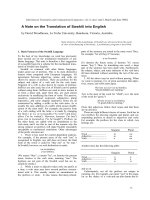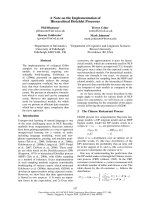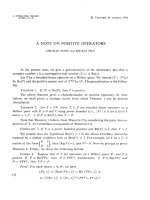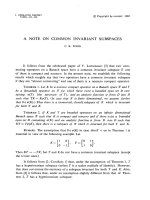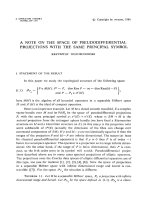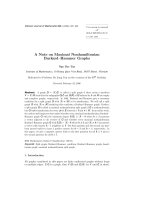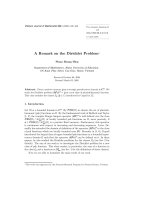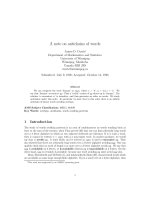Báo cáo toán học: "A note on the distance-balanced property of generalized Petersen graphs" ppt
Bạn đang xem bản rút gọn của tài liệu. Xem và tải ngay bản đầy đủ của tài liệu tại đây (70.68 KB, 3 trang )
A note on the distance-balanced property of
generalized Petersen graphs
∗
Rui Yang, Xinmin Hou,
†
Ning Li, Wei Zhong
Department of Mathematics
University of Science and Technology of China
Hefei, Anhui, 230026, P. R. China
Submitted: Aug 25, 2008; Accepted: Nov 13, 2009; Published : Nov 24, 2009
Mathematics S ubject Classifications: 05C75, 05C12
Abstract
A graph G is said to be distance-balan ced if for any ed ge uv of G, the numb er
of vertices closer to u than to v is equal to the number of vertices closer to v than
to u. Let GP (n, k) be a generalized Petersen graph. Jerebic, Klavˇzar, and Rall
[Distance-balanced graphs, Ann. Comb. 12 (2008) 71–79] conjectu red that: For
any integer k 2, th ere exists a positive integer n
0
such that the GP (n, k) is n ot
distance-balanced for every integer n n
0
. In this note, we give a proof of this
conjecture.
Keywords: generalized Petersen graph, distance-balanced graph
1 Introduction
Let G be a simple undirected graph and V (G) (E(G)) be its vertex (edge) set. The
distance d(u, v) between vertices u and v of G is the length of a shortest path between
u and v in G. For a pair of adjacent vertices u, v ∈ V (G), let W
uv
denote the set of all
vertices of G closer to u than to v, that is
W
uv
= {x ∈ V (G) | d(u, x) < d(v, x)}.
Similarly, let
u
W
v
be the set of all vertices of G that are at the same distance to u and v,
that is
u
W
v
= {x ∈ V (G) | d(u, x) = d(v, x)}.
A graph G is called distance-balanced if
|W
uv
| = |W
vu
|
∗
The work was supported by NNSF of China (No.10701068).
†
Corresponding author:
the electronic journal of combinatorics 16 (2009), #N33 1
holds for every pair of adjacent vertices u, v ∈ V (G).
Let uv be an arbitrary edge of G. Then d(u, x) − d(v, x) ∈ {1, 0 , −1}. Hence W
uv
=
{x ∈ V (G) | d(v, x) − d(u, x) = 1},
u
W
v
= {x ∈ V (G) | d(v, x) − d(u, x) = 0}, and
W
vu
= {x ∈ V (G) | d(v, x) − d(u, x) = −1} form a partition of V (G). The following
proposition follows immediately from the above comments.
Proposition 1 If |W
uv
| > |V (G)|/2 for an edge uv of G, then G is not distance-balanced.
Let n 3 be a positive integer, and let k ∈ {1, , n − 1} \ {n/2}. The generalized
Petersen gr aph GP (n, k) is defined to have the following vertex set and edge set:
V (GP (n, k)) = {u
i
| i ∈
n
} ∪ {v
i
| i ∈
n
},
E(GP (n, k)) = {u
i
u
i+1
| i ∈
n
} ∪ {v
i
v
i+k
| i ∈
n
} ∪ {u
i
v
i
| i ∈
n
}.
Jerebic, Klavˇzar, Ra ll [1] posed the following conjecture.
Conjecture 1 For any integer k 2, there exists a positive integer n
0
such that the
generalized Petersen graph GP (n, k) is no t di stance-balanced for every integer n n
0
.
Motivated by this conjecture, Kutnar et al. [3] studied the strongly distance-balanced
property of the generalized Petersen graphs and gave a slightly weaker result that: For
any integer k 2 and n k
2
+ 4k + 1, the generalized Petersen graph GP (n, k) is not
strongly distance-balanced (strongly distance-balanced graph was introduced by K utnar
et al. in [2]).
In this note, we prove the following theorem.
Theorem 2 For any integer k 2 and n > 6k
2
, GP (n, k) is no t di stance-balanced.
Theorem 2 gives a positive answer to Conjecture 1.
2 The Proof of Theorem 2
First we give a direct observation.
Proposition 3 For any i = 0, 1, 2, , n − 1, d(u
0
, u
i
) − d(v
0
, u
i
) = 1 if and only i f there
exists a shortest path f rom u
0
to u
i
which passes through the edge u
0
v
0
first.
We call the cycle induced by the vertices {u
0
, u
1
, · · · , u
n−1
} the outer cycle o f GP (n, k),
and the cycles induced by the vertices {v
0
, v
1
, · · · , v
n−1
} the inner cycles of GP (n, k). The
edge u
i
v
i
(0 i n − 1) is called a spoke of GP (n, k).
Proposition 4 Let GP (n, k) be a generalized Petersen graph with n 6k and k 2. If
3k i n − 3k, then there exists a s hortest path between u
0
and u
i
which passes through
the edge u
0
v
0
first.
the electronic journal of combinatorics 16 (2009), #N33 2
Proof. By symmetry, we only need consider the case 3k i n/2. Let P(u
0
, u
i
) be a
shortest path between u
0
and u
i
. Note that the path between u
0
and u
i
contained in the
outer cycle has length i. The path:
u
0
→ v
0
→ v
k
→ v
2k
→ v
3k
→ u
3k
→ u
3k+1
→ · · · → u
i
between u
0
and u
i
has length 5+i−3k. Since k 2, i+5−3k < i. Hence P(u
0
, u
i
) contains
spokes. Let u
s
v
s
and v
l
u
l
be the first spoke and the last one in P (u
0
, u
i
), respectively. If
s = 0, then the result follows. If s > 0, let P (u
s
, u
l
) be the segment of P (u
0
, u
i
) from
u
s
to u
l
. Define a map f : V (P (u
s
, u
l
)) → V (GP (n, k)) such that f (u
j
) = u
j−s
and
f(v
j
) = v
j−s
for u
j
∈ V (P (u
s
, u
l
)). Then the segment f(P (u
s
, u
l
)) is a segment from
u
0
to u
l−s
which first passes through the edge u
0
v
0
. Hence the path which first passes
through the segment P (u
0
, u
l−s
), then from u
l−s
to u
i
along the outer cycle is a shortest
path between u
0
and u
i
, as desired.
In what follows, we give the proof of the main theorem.
Proof of Theorem 2: By Proposition 4, there exists a shortest path from u
0
to u
i
which passes through u
0
v
0
first for each 3k i n − 3k. By Proposition 3, d(u
0
, u
i
) −
d(v
0
, u
i
) = 1. Hence there are more than n − 6k vertices in the outer cycle which satisfy
d(u
0
, u
i
) − d(v
0
, u
i
) = 1.
Now we count the number of vertices in the inner cycle of GP (n, k) satisfying d(u
0
, v
i
)−
d(v
0
, v
i
) = 1. For i = mk (m = 0, 1, 2, · · · , ⌊n/2k⌋), it is easy to check that d(u
0
, v
i
) = m+
1 and d(v
0
, v
i
) = m. Hence d(u
0
, v
i
) − d(v
0
, v
i
) = 1. By symmetry, d(u
0
, v
i
) − d(v
0
, v
i
) = 1
for i = n − mk (m = 1, 2, · · · , ⌊n/2k⌋). Hence there are at least 2⌊n/2k⌋ vertices in the
inner cycle satisfying d(u
0
, v
i
) − d(v
0
, v
i
) = 1.
If n 6k
2
, then the number of the vertices x satisfying d(u
0
, x) − d(v
0
, x) = 1 is more
than n − 6k + 2⌊n/2k⌋ n − 6k + 2⌊6k
2
/2k⌋ = n. Hence |W
v
0
u
0
| > n = |V (GP (n, k))|/2.
By Proposition 1, GP (n, k) is not distance-balanced for n 6k
2
and k 2.
References
[1] J. Jerebic, S. Klavˇzar, D. F. Rall, Distance-balanced graphs, Ann.Comb. 12 (2008)
71-79.
[2] K. Kutnar, A. Malniˇc, D . Maruˇsiˇc,
ˇ
S. Miklaviˇc, Distance-balanced graphs: symmetry
conditions, Discrete Math. 306 (2006), 1 881-1894.
[3] K. Kutnar, A. Malniˇc, D. Maruˇsiˇc, S. Miklaviˇc, The strongly distance-balanced prop-
erty of the generalized Petersen graphs, Ars math Contemp., 2 (2009 ), 41-47.
the electronic journal of combinatorics 16 (2009), #N33 3
